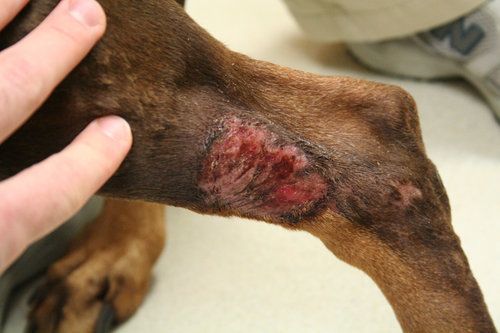Acral Lick Granuloma in Dogs
Overview
Acral lick granuloma is a skin disorder that is most commonly seen in dogs. What often begins as a small sore spot will significantly worsen and spread due to continuous licking. Once a diagnosis of acral lick granuloma is reached, the skin may be deeply affected.
As bacteria thrive and inflammation increases, the lesion will become incredibly sore and uncomfortable. Although acral lick granuloma in dogs has been referred to as “a dermatology nightmare” – there are treatments available.
What Causes This Skin Condition to Develop?
There are several theories when it comes to the cause of acral lick granuloma in dogs.
Unfortunately, many experts agree that there is a psychological and behavioral component to this condition, which can make it challenging to effectively intervene. In some dogs, boredom may play a role, while others may lick due to psychological stress (i.e. the introduction of a new dog or baby, separation anxiety, etc.).
Other possible causes include:
- Allergic inhalant dermatitis, causing inflammation and itching to develop
- A foreign object, such as a bee sting or a thistle
- Joint or bone pain may draw attention to the area, causing the dog to begin licking
- Hypothyroidism, especially in Black Labs
Select breeds may also face an increased risk of acral lick granuloma, including Doberman Pinschers, Golden Retrievers, Great Danes, Labrador Retrievers, Boxers, Irish Setters, Pointers, and Weimaraners.
Also, although both males and females of all ages are impacted by acral lick granuloma, males tend to have a higher incidence, as well as older dogs.
Perpetuating Variables to Consider
Unfortunately, even if this skin disorder is initially triggered by a transient variable, such as an allergy, a “licking cycle” will likely commence. This cycle will likely continue and worsen until a dog receives treatment.
Other perpetuating variables include:
- A deep infection, such as Staphylococcus, which tends to be the most common
- Ruptured hair follicles, initiating an inflammatory response
- Compulsive behavior – licking may release endorphins, resulting in strong reinforcement
Can Acral Lick Granuloma Be Treated?
Acral lick granuloma can be fairly tricky to treat as there is no universal cure, and treatment will vary depending on whether lesions are early and mild or chronic.
First, a veterinarian will need to determine the underlying cause in order to understand why the dog is licking in the first place.
Before a treatment plan is created, they will want to rule out clinical conditions such as a bacterial infection. That way, they can focus their attention on possible behavioral interventions, which may lead to relapsing.
In most cases, a topical medication will be prescribed to treat the lesion. The goal is to reduce itching so that the dog will lick less while the owner focuses on behavioral modification.
In select cases, radiation therapy or surgery may be recommended. Acupuncture has also been shown to be highly effective, showcasing a reduced rate of licking and increased hair regrowth.
Cost of Treatment: $25 – $50
Treatment for acral lick granuloma is often an ongoing process and requires owners to work closely with their veterinarian, as several approaches may be required before the best solution is found for each unique case.
Protect your pup in times in need – get coverage today!
Other Skin Issues in Dogs
Related Content




















